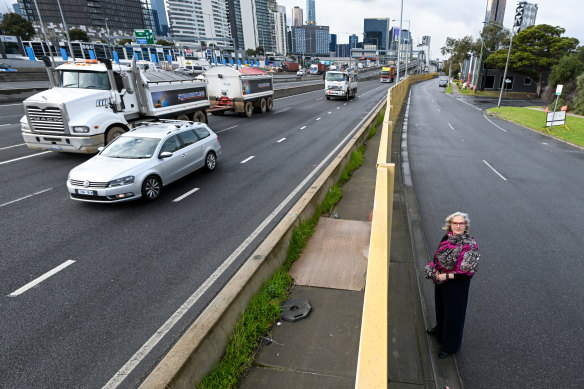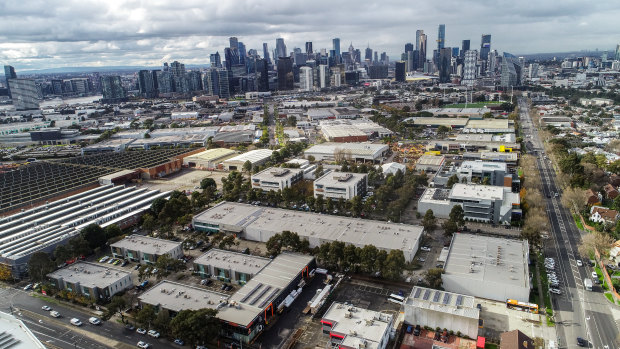Fishermans Bend could ease Melbourne’s housing crisis with more than 15,000 new apartments already approved or on the way, but developers, businesses and local councils warn the state government’s proposed tram lines to unlock the dwellings are nowhere to be seen.
This week the Victorian Office of the Auditor General revealed it would investigate the performance of the state agencies managing the development of Fishermans Bend, more than a decade after the area was controversially rezoned by then-Liberal planning minister Matthew Guy.
The audit will probe whether state agencies are on track with a 2018 masterplan for the area that aims to see 80,000 people living on the 480-hectare peninsula by 2050, and host 80,000 jobs.

Bernadene Voss stands where a bridge for a tram to Fishermans Bend was proposed to be built by 2025.Credit: Joe Armao
Major stakeholders in Fishermans Bend are not expecting a glowing report card when the auditor general’s office returns its report in the coming year – largely for the failure to start constructing a light rail to and from an area that is more than twice the size of the CBD.
“By far and away the biggest catalyst for any movement in Fishermans Bend is public transport,” says former mayor of the City of Port Phillip and Fishermans Bend Business Forum president Bernadene Voss. “And I don’t know of any movement whatsoever ever [on trams].”
A mooted tramline and bridge that would connect the CBD to Fishermans Bend by 2025 – outlined in a state government plan from 2018 – is nowhere to be seen. It was meant to be delivered some time between 2020 and 2025, leaving the government two years to meet its own deadline. None of the stakeholders expect that to happen.
In the midst of a housing crisis, the state government is preparing to announce in coming months what Premier Daniel Andrews has described as “the biggest shake-up” to planning policy in 30 years to supercharge housing supply in inner and middle Melbourne.

A stones-throw from the CBD but difficult to access without a car, Fishermans Bend is meant to be home to 80,000 people within 27 years.Credit: Joe Armao
Voss, alongside developers, councils, planners and community members, wants the government to revisit Australia’s largest urban renewal project on the city’s doorstep.
Cath Evans, Victorian executive director of the powerful lobby group Property Council of Australia, said it was “clear from the lack of recent activity that the planned development of the Fishermans Bend precinct has stalled” and encouraged the government to refocus its attention on it immediately.
“At a time when housing affordability is at crisis levels, the many thousands of dwellings locked up in the Fishermans Bend precinct represents a significant potential injection of supply into a market that desperately needs it,” she said. “Something that shouldn’t be held up for want of a tramline.”
After winning government in 2014, the Andrews Labor government gleefully took great political mileage in “fixing Matthew Guy’s mess” at Fishermans Bend and in 2018 launched the Fishermans Bend Framework – an 84-page master plan to guide sustainable development in the area under the guidance of an appointed board of experts.
Under the plan, Fishermans Bend would feature plenty of green space, apartment buildings, affordable housing, new schools, and thousands of high-tech and advanced manufacturing jobs in the industrial area.
Anchoring the employment precinct would be a new Melbourne University engineering and design campus, located on the site of the former Holden car factory.
Tramlines were crucial to the plan.
“For 80,000 people to live there and 80,000 to work there, there’s no space for cars because it’s a peninsula. The conclusion was it couldn’t work in any other way,” says Rob McGauran, adjunct professor of urban design at Monash University.
McGauran was one of eight people appointed by Guy’s successor Richard Wynne in 2015 to a committee to devise the “recast” strategy for the area.
The resulting plan set a goal for one of two proposed tram lines – an extension of the Collins Street/Docklands route 11 tram to Fishermans Bend – to be delivered by 2025. But all momentum from the government has stalled, says Voss, which means many properties were being used as “a truck parking site of a warehouse” instead of housing, shops or services.
Exclusive planning data provided to The Age from housing data firm Charter Keck Cramer illustrates how developers are largely interested in the Montague area – closest to the existing Port Melbourne tram line.
According to the data, which tracks developments larger than 10 dwellings, just 1790 apartments have been constructed in Fishermans Bend across 10 buildings since the area was rezoned. One development consisting of 23 homes is under construction, and another building is yet to be constructed but is being marketed as having 213 units.
There are a further 18 approved permits for 7339 apartments sitting in the pipeline, and a further 15 buildings representing 7509 apartments in the application phase.
Richard Temlett, director at Charter Keck Cramer, said developers were unlikely to progress developments at scale without public transport.
“Unfortunately, what’s happened with Fishermans Bend is it has the fundamentals, it has the planning support, but it doesn’t have the infrastructure coming and going into the city and by extension not the market demand,” he said.
Melbourne University’s 2021 announcement to open the first stage of its new campus by 2025 has also been pushed out, with a spokesperson confirming this week that the first stage would not be completed by 2031 and that construction would only start next year.
Some smaller facilities would open in 2026 but not for masses of students.
“The university and its government and industry partners in the precinct will need significantly improved transport links, consistent with the state’s vision for this world-class precinct,” the spokesperson said in a statement.
McGauran said his committee found a bus service would not “cut the mustard” for the university.
“How will Melbourne University, in reality, have a successful campus where students either have to drive or catch a bus or walk through two kilometres of the business park, where the lights are off after 7pm at night?”
It’s not just transport that has stalled, with the City of Port Phillip concerned about the lack of progress on promised parks and community facilities in the areas where buildings had gone ahead.
Half of Fishermans Bend falls within the City of Port Phillip, the other half in the City of Melbourne.
“We are concerned the population growth brought by these developments has already put tremendous pressure on our council’s nearby open space facilities for community sport and recreation,” Mayor Heather Cunsolo said.
Melbourne Lord Mayor Sally Capp said major transport “including the Fishermans Bend tram extension and Melbourne Metro Two rail project” was critical for the viability of the precinct.
Many stakeholders believe the pandemic changed the priorities for the state government, as it radically changed the way Melburnians use the city, and that other ‘big build’ projects like the landmark Suburban Rail Loop project had sucked attention and funds away from Fishermans Bend.
Consultancy firm AECOM put the likely cost of extending the existing tram lines down Collins Street into Fishermans Bend at $1 billion in 2018. The Suburban Rail Loop project is on track to cost more than $125 billion.
McGauran said in the wider scheme of infrastructure spend, the money needed for a tram line was small change for the government.
“Light rail into Fishermans Bend is a rounding error in terms of the Suburban Rail Loop, in terms of how much it would cost, and it would be disproportionately impactful for Australia.”
There are obvious physical barriers to developing Fishermans Bend: parts are at risk of flooding and contaminated soil from decades of noxious industries needs to be dealt with.
Sources with knowledge of the government’s internal work on Fishermans Bend also say a dispute between the government and developers over the location and style of a bridge over the Yarra for the tram had also stalled progress, as the proposed path of the tram bridge would impact a riverside marina for residents of luxury riverside apartments.
Before the 2022 federal election, federal Labor also promised $3 million for another ‘transport feasibility study’ with the state government, which has yet to surface.
The Victorian government declined The Age’s requests to interview any of the six-person Fishermans Bend Development Board.
A spokesman for Planning Minister Sonya Kilkenny instead issued a statement saying the government had delivered more weekday services to existing bus routes for Fishermans Bend.
The statement said the government had made a commitment of $179.4 million to deliver Stage 1 of the Fishermans Bend Innovation Precinct by 2026, which involved building a new road linking Salmon Street and Todd Road, and that it had “funded development to understand the potential of trams”.
The Morning Edition newsletter is our guide to the day’s most important and interesting stories, analysis and insights. Sign up here.
https://news.google.com/rss/articles/CBMif2h0dHBzOi8vd3d3LnRoZWFnZS5jb20uYXUvbmF0aW9uYWwvdmljdG9yaWEvZmlzaGVybWFucy1iZW5kLXdhcy1tZWFudC10by1ob3VzZS04MC0wMDAtcGVvcGxlLXdoYXQtaGFwcGVuZWQtMjAyMzA2MjctcDVkanNqLmh0bWzSAQA?oc=5
2023-06-30 19:00:00Z
CBMif2h0dHBzOi8vd3d3LnRoZWFnZS5jb20uYXUvbmF0aW9uYWwvdmljdG9yaWEvZmlzaGVybWFucy1iZW5kLXdhcy1tZWFudC10by1ob3VzZS04MC0wMDAtcGVvcGxlLXdoYXQtaGFwcGVuZWQtMjAyMzA2MjctcDVkanNqLmh0bWzSAQA
Bagikan Berita Ini














0 Response to "Fishermans Bend was meant to house 80,000 people. What happened? - The Age"
Post a Comment